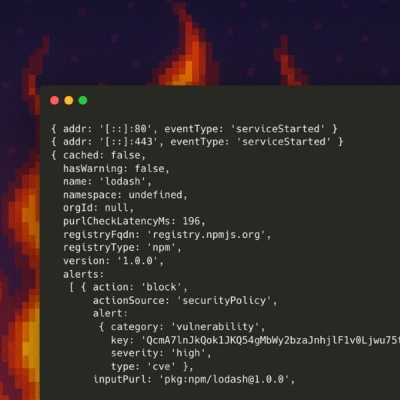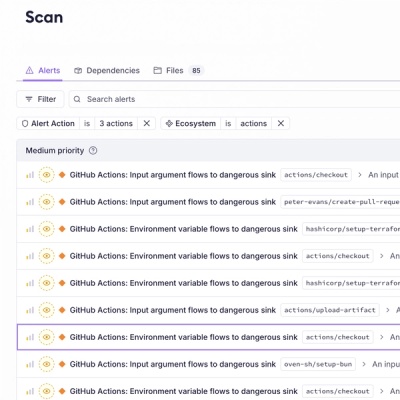
Product
Introducing Socket Firewall Enterprise: Flexible, Configurable Protection for Modern Package Ecosystems
Socket Firewall Enterprise is now available with flexible deployment, configurable policies, and expanded language support.
asset-bundle
Advanced tools
Build process that transforms (multiple) SVG assets into a asset-parser compatible bundle
Transforms your SVG assets in to asset-provider compatible bundle that
contains multiple SVG assets.
The bundle process executes the following steps to produce a bundle:
root option is set, it
will use the folder structure as "namespace", when the option is omitted the
name of the asset is just file name without extension.svgo so all information that
cannot be used is removed. This ensures that the assets that we bundle are as
small as possible.viewBox properly is available or we render
the svg with puppeteer and extract the calculated SVG bounding
box. The bounding box information is then used to construct the viewBox.svgs elements. We want to
minimize impact to mobile device CPU's and battery life so this optimization
step happens during the bundling phase.asset-parser library.npm install --save asset-bundle
The bundler has an optional dependency on puppeteer. This module is used
to resolve the viewBox of a given svg asset if there is no viewBox or
height/width combination available on the asset. If these properties are
missing on some of your assets you can either manually update them, or install
puppeteer and it will automatically extract the correct viewBox from your
svg.
npm install --save puppeteer
import Bundle from 'asset-bundle';
The Bundle constructor requires a single argument.
paths An array of paths that point to the SVG files that need to be
included in the resulting bundle.config Optional configuration that allows you to customize the SVGO process.
Do not touch this unless you know what you're doing, like really know what
you are doing.import path from 'path';
const bundle = new Bundle([
path.join(__dirname, 'folder', 'filename.svg'),
path.join(__dirname, 'folder', 'another.svg'),
path.join(__dirname, 'folder', 'more.svg')
]);
The following config options are available:
root The root of the directory where the bundling process is taking place.
This will be used to generate "namespaced" names of assets when they are
deeply nested in folders.multipass Enable or disable multipass in svgo. Defaults to false;svgo An Array of plugins that need to be enabled in svgo. Highly
recommended to not touch this, unless you know what you're doing, know
the order of the svgo plugins, and which svgo plugins are vital for the conversion process.Registers a new transformation hook that is ran on every element. This allows you to transform, remove or add addition attributes or even change the component completely.
The method requires 2 arguments:
name A unique name for your transformationfn Function that does the actual transforming.bundle.modify('what', function (attr, element, name) {
});
As you can see in the example above it receives 3 arguments in the transformation function:
attr An object that contains all attributes of the SVG elements.element Reference to the DOM element of the SVG that we just parsed.name Component name of the element.If you want to modify the attributes you can just alter the attr object.
If you wish to change the component name, you need to return a new name. We
assume that you return undefined in all other cases as signal that the
component name should not be changed.
Register a new plugin.
Plugin The constructor of the plugin function....args The rest of the arguments for the plugin.bundle.plugin(PluginConstructor, {
options: 'for',
the: 'plugin'
});
It returns the instance of the plugin for debugging sake.
Starts the transformation process of the supplied SVG files. Please note that this is a heavy operation and should really be done during build time of your assets.
The run method requires a single argument:
fn Error first completion callback. The first argument will be an optional
error argument, the second argument will be the resulting bundle. The bundle
is already encoded in the correct format that is accepted by the
asset-parser library.import path from 'path';
import fs from 'fs';
bundle.run(function (err, str) {
if (err) throw err; // Don't actually throw it, just handle it.
fs.writeFileSync(path.join(__dirname, 'bundle.svgs'), str);
});
It is worth noting that we use the filename of each SVG as name for the asset.
So when you're fetching this bundle using the asset-provider library your
assets would be named:
filenameanothermore(As those were the files that our bundle example was using).
The Bundle extends EventEmitter and emits events during the various of
transformation cycles. The following events are emitted (and in order):
read Supplied paths have been read.optimize SVG's have been optimized.parse AST has been generated from the SVGS.viewBox All viewBox's have been calculated.traverse AST has been traversed and output structure is generated.done Structure has been encoded.All events will receive the following arguments:
err An Error if that happens during the transformation step.svgs An Array of SVG objects.The only exception for this is the done event, which will receive:
err An Error if that happens during the transformation step.result Encoded result.svgs An Array of SVG objects.bundle.on('done', (err, data, svgs) => {
console.log(svgs);
});
FAQs
Build process that transforms (multiple) SVG assets into a asset-parser compatible bundle
The npm package asset-bundle receives a total of 40 weekly downloads. As such, asset-bundle popularity was classified as not popular.
We found that asset-bundle demonstrated a not healthy version release cadence and project activity because the last version was released a year ago. It has 2 open source maintainers collaborating on the project.
Did you know?

Socket for GitHub automatically highlights issues in each pull request and monitors the health of all your open source dependencies. Discover the contents of your packages and block harmful activity before you install or update your dependencies.

Product
Socket Firewall Enterprise is now available with flexible deployment, configurable policies, and expanded language support.

Security News
Open source dashboard CNAPulse tracks CVE Numbering Authorities’ publishing activity, highlighting trends and transparency across the CVE ecosystem.

Product
Detect malware, unsafe data flows, and license issues in GitHub Actions with Socket’s new workflow scanning support.